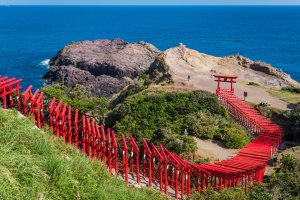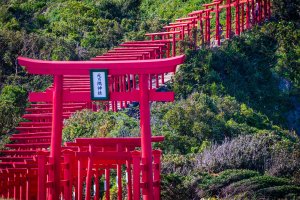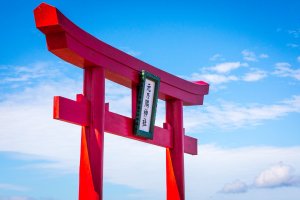Shinto shrines seem to me to relate a different sense than one gets from a sacred place of a monotheistic religion. It’s not only about a deity, or in this case, a legendary white fox who appeared just a few decades ago to a local and called for the building of this shrine. Nor is humanity’s relation to deities the focus that comes to mind as I pass through these 123 bright red torii, or gates.

Nature, and humanity’s fundamental connection to Nature, arise easily to the fore here. With just about any view of the winding gates, the land, the plants, the sea, and the sky tie together to register this scene in our minds as somewhere special.

Locals may not have needed a shrine to notice what this place had to offer, but the twisting passageway of gates sure help it stand out. They work as a device that draws people in from afar like an antenna and then anchors the scene. You are channeled into the “tunnel,” yet there’s still openness to the surroundings. The sun shines through the latticework of the gates. The wind brings the sea salt in to you. The vegetation reaches out to you. As you take in more of the location, all of your senses come more acute and a feeling of rejuvenation begins to swell with the connection.

All the denizens, flowers and greenery, and stunning waters reveal themselves slowly as you move through and take time to absorb the scene. What at first seemed just plain dirt suddenly has a butterfly darting through the space. A single exquisite flower appears elsewhere in a swathe of green or grey. Hunks of rock reveal a kaleidoscope of mineral deposits once you give them your attention. At the base of the cliffs, on rough days, a blowhole spouts seawater into the air. Stories of legend and the human endeavor made obvious by the gates add to the natural colors of the setting.

The feeling of connectedness is something you can sense without even processing all of these thoughts consciously—without knowing anything of the Shinto religion or the history of this shrine.

So, after you take the obligatory pictures of the stunning torii—and I recommend having a model with you to add a subject to these beautiful backdrops—hang out for an hour or two and give some thought to why the white fox bothered to make a fuss about this setting. Chances are good that you’ll experience something special and have a rather enjoyable day.
元ノ隅稲成神社—Motonosumi Inari Jinja—Motonosumi Inari Shrine
龍宮の潮吹—Ryuuguu no Shiofuki—The Spouting Palace of the Dragon King (blowhole)

































